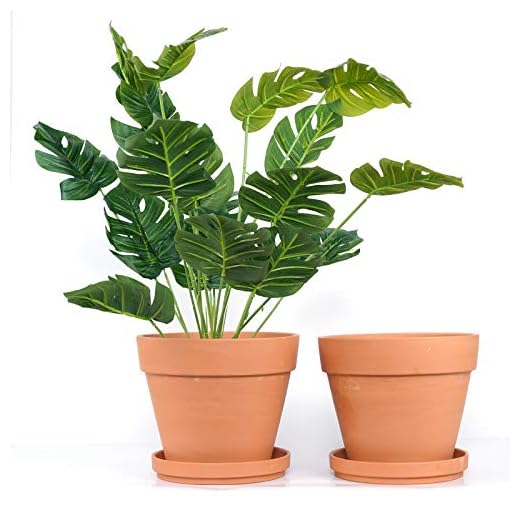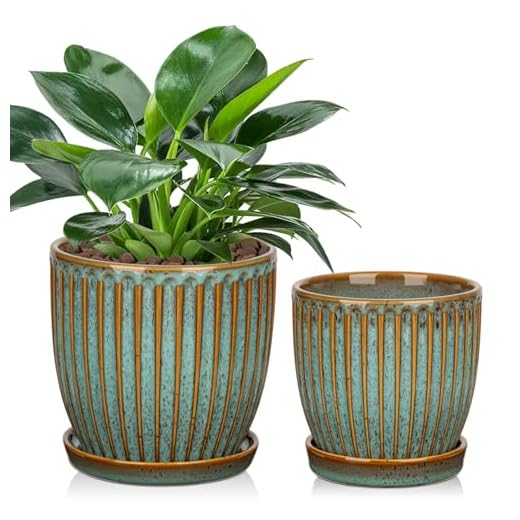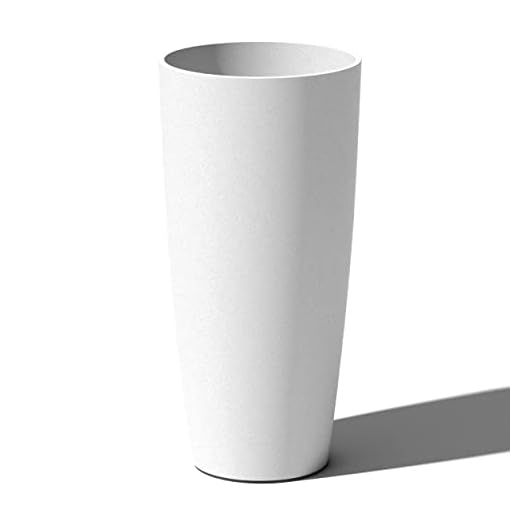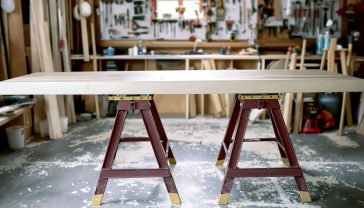The Guide to Container Gardening in the UK: From Balconies to Back Gardens
The ultimate, comprehensive guide to container gardening for British gardeners. Transform any small space into a green oasis with expert tips and plant advice.

This post may contain affiliate links. If you make a purchase through these links, we may earn a commission at no additional cost to you.
Gardening is stitched into the very fabric of British life. We’re a nation of allotment holders, window box curators, and secret gardeners, coaxing life from our soil with a cup of tea in hand. But what if you don’t have a sprawling lawn or a vegetable patch? What if your little patch of Blighty is a balcony, a patio, a doorstep, or just a sunny windowsill?
Well, that’s where the magic of container gardening comes in. It’s the brilliant, democratic idea that you don’t need a massive garden to create your own green oasis. It’s about cultivating beauty, growing your own grub, and connecting with nature, no matter how limited your space. Think of it as gardening, just in miniature. From the tiniest terracotta pot bursting with herbs to a grand planter overflowing with summer blooms, container gardening allows anyone to get their hands dirty and grow something wonderful.
This isn’t some newfangled trend. Humans have been growing plants in pots for thousands of years, from the legendary Hanging Gardens of Babylon to the elegant orangeries of grand stately homes. But today, it’s more relevant than ever. As our homes get smaller and our lives get busier, pots provide a flexible, manageable, and wonderfully creative way to garden.
So, whether you’re a complete novice wondering what ‘compost’ actually is, or a seasoned gardener looking to perfect your patio paradise, you’ve come to the right place. This is your ultimate guide to mastering container gardening in the UK. We’ll cover everything from choosing the perfect pot and the right soil to selecting plants that will thrive in our wonderfully unpredictable British weather. Let’s get growing.
What Exactly is Container Gardening? The Big Idea in a Small Pot
At its heart, container gardening is beautifully simple: it’s the practice of growing plants exclusively in containers instead of in the ground. That’s it. But within that simple definition lies a whole world of creativity and possibility.
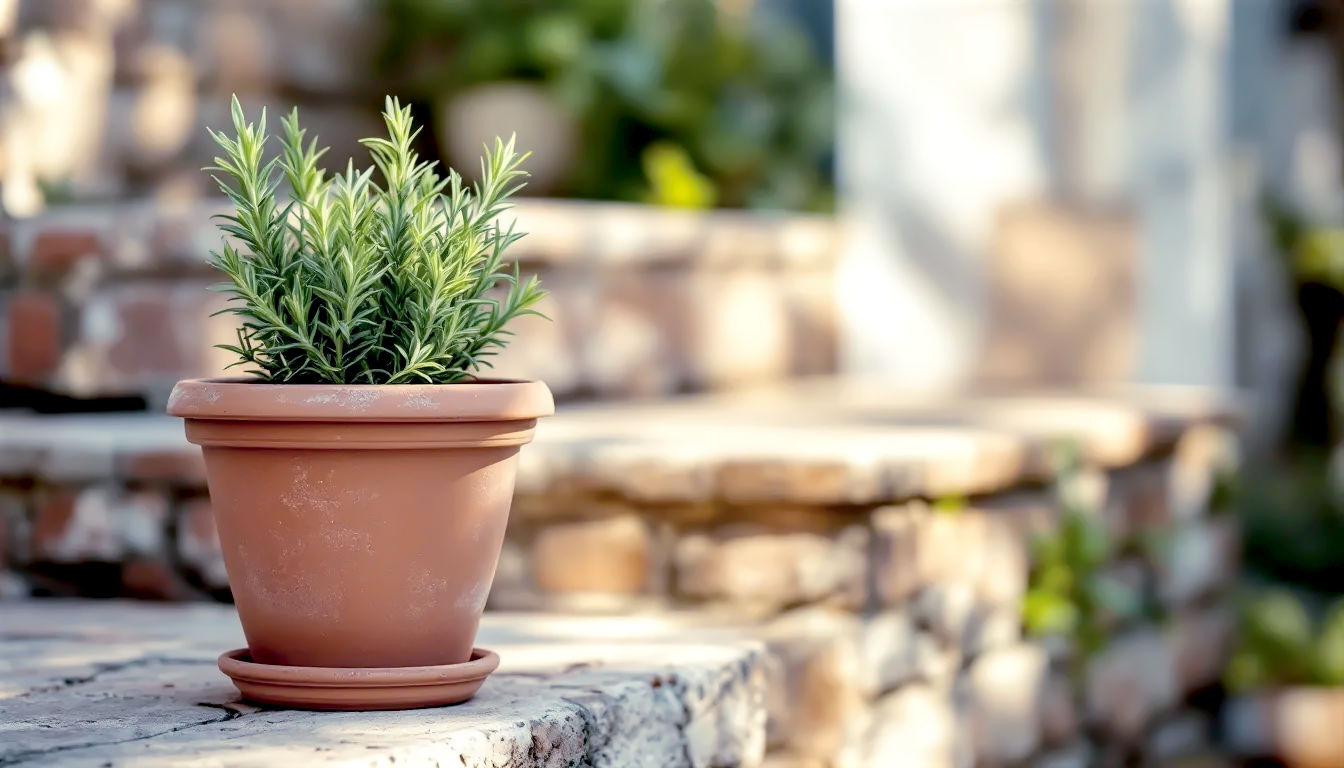
The ‘container’ can be anything that holds soil and allows for drainage. We’re talking traditional terracotta pots, sleek modern planters, rustic wooden barrels, repurposed buckets, hanging baskets, window boxes, and even old wellies! The ‘plants’ can be anything from vibrant flowers and ornamental grasses to delicious vegetables, herbs, and even small trees and shrubs.
The key difference, of course, is that a plant in a container is entirely dependent on you for its survival. It’s living in a little self-contained ecosystem. Unlike a plant in the ground, its roots can’t stretch out to find water or nutrients. It relies on you to provide the right amount of water, the correct type of soil, and the food it needs to flourish.
This might sound like a big responsibility, but it’s also what makes container gardening so powerful. You are in complete control. You decide the soil, the location, and the conditions. This means you can grow plants that might not survive in your garden’s natural soil. Got heavy clay soil? No problem, you can fill a pot with the perfect ericaceous compost for a beautiful rhododendron. Is your garden a bit of a wind tunnel? You can move your pots to a sheltered spot. It’s your garden, on your terms.
Why Every Brit Should Give Pot Gardening a Go
The benefits of growing in containers are huge, especially for modern life in the UK.
- It’s Perfect for Any Space: This is the big one. Whether you have a tiny London balcony, a paved courtyard in Manchester, or just a front step in Cornwall, you can have a garden. It turns unused nooks and crannies into vibrant, living spaces.
- Total Flexibility: Fancy a change? Just move the pots around! You can rearrange your garden for a party, move plants to follow the sun, or bring tender specimens indoors when a frost is forecast. It’s like rearranging the furniture, but with plants.
- Fewer Weeds, Less Hassle: Let’s be honest, nobody loves weeding. In a container, you’re starting with fresh, sterile compost, so weed problems are minimal. This makes it a much less back-breaking form of gardening.
- Accessibility for Everyone: For those with mobility issues, bending down to garden beds can be difficult or impossible. Raised containers and pots on tables bring the garden up to a comfortable height, making it accessible to everyone.
- Create Instant Impact: Want to brighten up your front door or add a splash of colour to a dreary patio? A few well-chosen pots can transform a space in an afternoon. There’s no waiting for things to ‘establish’ in the same way.
- Grow What You Love: You can tailor the conditions in each pot to the specific needs of the plant. This allows you to grow acid-loving blueberries next to sun-loving lavender, something that’s tricky to do in open ground.
Of course, it’s not without its challenges. Pots can dry out quickly, and plants will need regular feeding. But with a bit of know-how—all of which we’ll cover here—these are easy hurdles to overcome.
Gearing Up for Success: Your Container Gardening Toolkit
Before you dash off to the garden centre, let’s talk about the essentials. You don’t need a shed full of expensive gear, but a few key items will make your life much easier and your plants much happier.
Choosing the Perfect Pot: More Than Just a Pretty Face
The container you choose is your plant’s home, so it’s worth getting it right. It’s not just about looks; the material, size, and drainage all play a crucial role.
Pot Materials: The Pros and Cons
- Terracotta (Clay): The classic choice, and for good reason. Terracotta pots are porous, meaning air and water can pass through the walls. This helps to stop the soil from getting waterlogged and keeps the roots healthy. They look beautifully rustic and age wonderfully. The downside? They dry out very quickly in summer and can crack in a hard frost if left waterlogged. Best for: Drought-tolerant plants like lavender, rosemary, and succulents.
- Glazed Ceramic: These are essentially terracotta pots with a waterproof glaze. They come in a huge range of colours and styles, and because they aren’t porous, they hold onto water for much longer. They can be heavy and are still susceptible to cracking in winter. Best for: Thirsty plants like ferns and summer bedding.
- Plastic: Don’t turn your nose up! Modern plastic pots can look surprisingly stylish. They are lightweight, cheap, and excellent at retaining moisture. They won’t crack in the frost, either. Look for ones made from recycled materials for a greener choice. Best for: Just about anything, especially if you’re on a budget or need something lightweight for a balcony.
- Wood: Wooden planters, like barrels or troughs, have a lovely, natural look. They offer good insulation for roots, protecting them from extreme heat and cold. They will eventually rot, but you can extend their life by lining them with a plastic sheet (remember to poke holes in it!). Best for: Growing vegetables, or for a rustic cottage-garden look.
- Metal: Galvanised steel or zinc planters can create a very sharp, contemporary look. They are durable and lightweight. The main drawback is that metal heats up a lot in direct sun, which can cook the roots. It’s best to line them or use them in a shadier spot. Best for: Creating a modern, urban-style garden.
Size Matters (Seriously)
It’s tempting to put a small plant in a small pot, but this is a common mistake. A larger pot holds more soil, which means it holds more moisture and nutrients. This gives the plant’s roots more room to grow and provides a buffer against drying out. As a general rule, always choose a pot that looks slightly too big for the plant. You’ll be rewarded with a healthier, happier plant that needs less frequent watering.
The Golden Rule: Drainage is Everything!
If you remember only one thing, make it this: your pot must have drainage holes. Without them, rainwater and your watering can will turn the soil into a swamp. Plant roots need air as well as water, and sitting in waterlogged soil is the quickest way to kill them. If you fall in love with a beautiful pot that doesn’t have holes, you can either try to drill some yourself (using a masonry bit for ceramic or terracotta) or use it as a decorative outer pot, with the plant in a plastic pot with holes slipped inside.
The Foundation of Life: Soil and Compost
You can’t just dig up some soil from the garden and stick it in a pot. Garden soil is too heavy, compacts easily, and may contain pests and diseases. For container gardening, you need to use a specially formulated potting mix or compost.
Understanding Potting Compost
When you go to a British garden centre, you’ll be faced with a dizzying array of bags all labelled ‘compost’. Here’s a simple breakdown:
- Multipurpose Compost: This is the jack-of-all-trades. It’s a good starting point for most plants, especially annual bedding plants that only live for one season. It’s often peat-based or made from a peat-free alternative like coir (coconut fibre) or composted bark. The quality can vary, so it’s worth paying for a reputable brand.
- John Innes Composts: This isn’t a brand name, but a recipe. John Innes composts are soil-based (loam-based), meaning they are heavier and hold onto water and nutrients for longer than multipurpose composts. They are ideal for plants that will live in the same pot for a long time, like shrubs, perennials, and small trees. They come in different formulas:
- No. 1: For seedlings and young plants.
- No. 2: For potting on most established plants.
- No. 3: For mature, hungry plants in their final pots.
- Ericaceous Compost: This is a special type of acidic compost for plants that hate lime (alkaline conditions). If you want to grow rhododendrons, azaleas, camellias, or blueberries in a pot, you must use this.
To Peat or Not to Peat?
For decades, peat was the main ingredient in potting composts. However, we now know that harvesting peat destroys precious peat bog habitats, which are vital for wildlife and for storing carbon. The UK government is phasing out the sale of peat compost to amateur gardeners. The good news is that peat-free alternatives have improved massively in recent years. They are often made from coir, wood fibre, and green compost. They can behave a little differently—sometimes drying out faster—but they are the sustainable and responsible choice.
Essential Tools for the Pot Gardener
- A good trowel: For scooping compost and digging holes.
- A watering can: Choose one with a ‘rose’ (the sprinkler head) for gentle watering of young plants. A long-spouted one is great for reaching the back of pots.
- Gardening gloves: To keep your hands clean and protected.
- Secateurs: For pruning and deadheading.
Let’s Get Planting: Your Step-by-Step Guide
Right, you’ve got your pots, your compost, and your plants. Now for the fun bit! The process is the same whether you’re planting a single specimen or creating a mixed display.
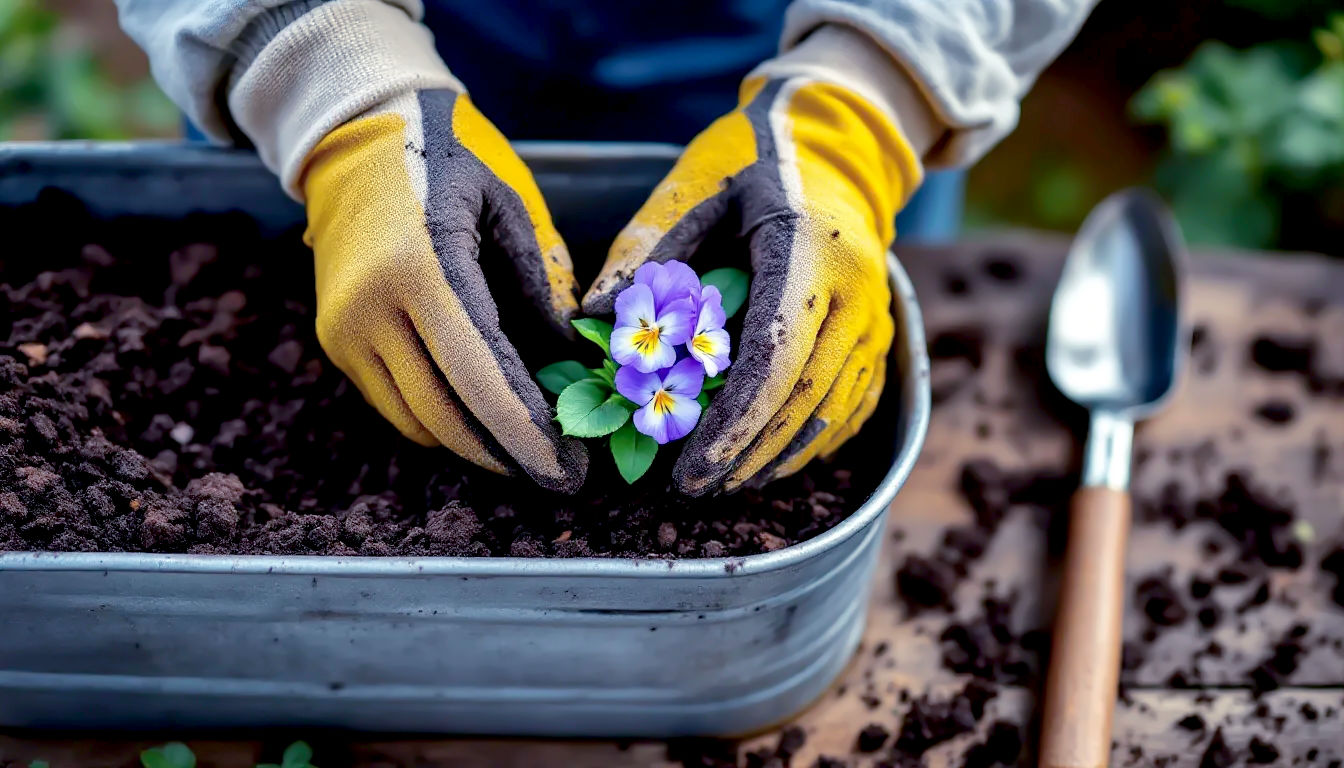
Step 1: Cover the Drainage Holes (or Don’t?)
For years, the advice was to put a layer of ‘crocks’—broken pieces of terracotta pots, stones, or polystyrene—at the bottom of a container to improve drainage. Modern thinking has actually debunked this. All it really does is create a layer of waterlogged soil just above the crocks, which is exactly what you want to avoid.
The best practice now is simply to place a piece of mesh or a large, flat stone over the hole to stop the compost from washing out. That’s it.
Step 2: Add the Compost
Fill your pot with compost until it’s about two-thirds full. Give the pot a gentle shake to settle the compost, but don’t press it down too firmly. You want to keep some air in the mix. It’s a good idea to mix in some slow-release fertiliser granules at this stage. This will act like a packed lunch for your plants, feeding them steadily over the season.
Step 3: Position Your Plants
Carefully remove the plant from its nursery pot. If the roots are tightly coiled (this is called being ‘pot-bound’), gently tease them out with your fingers to encourage them to grow outwards into the new compost.
Place the plant in the pot. The aim is to have the top of its root ball sitting about an inch (2-3cm) below the rim of the pot. This gap is essential for watering; it creates a reservoir so water can soak in rather than just running straight off the top.
If you’re creating a mixed planting, this is your chance to get creative. A classic recipe is the ‘Thriller, Filler, Spiller’ method:
- Thriller: A tall, eye-catching plant in the centre (e.g., a fuchsia, cordyline, or ornamental grass).
- Filler: Mounded plants that surround the thriller and fill the space (e.g., petunias, geraniums, or begonias).
- Spiller: Trailing plants that cascade over the edge of the pot (e.g., ivy, lobelia, or bacopa).
Step 4: Fill, Firm, and Water
Add more compost around the plants, gently firming it down with your fingertips to remove any large air pockets. Make sure you don’t bury the stems any deeper than they were in their original pot.
Finally, and this is crucial, give the pot a thorough watering. Water until you see it running out of the drainage holes at the bottom. This settles the compost around the roots and ensures the whole pot is evenly moist.
Caring for Your Container Garden: The Keys to Success
Once your pots are planted, a little regular care and attention is all they need to look fantastic all season long.
Watering: The Most Important Job
Because they have a limited amount of soil, containers dry out much faster than garden beds. Getting the watering right is the single most important task in container gardening.
- How often? There’s no simple answer. It depends on the weather, the size of the pot, and the type of plant. In the height of a British summer, you might need to water every single day. In cooler, overcast weather, it might be every few days.
- The Finger Test: The best way to check is to stick your finger into the compost up to the first knuckle. If it feels dry, it’s time to water. If it feels damp, leave it for another day.
- Water Thoroughly: When you do water, do it properly. Give the pot a really good soak until water runs out of the bottom. A quick splash only wets the top layer of compost, leaving the roots below bone dry.
- Morning is Best: Watering in the morning is ideal, as it sets the plant up for the day and any moisture on the leaves has time to evaporate, which helps prevent fungal diseases.
- Use Rainwater: If you can, collect rainwater in a water butt. It’s better for your plants (especially ericaceous ones) and for the environment.
Feeding: A Hungry Plant is a Happy Plant
The nutrients in multipurpose compost will only last for about 4-6 weeks. After that, your plants will need feeding to keep them growing strongly and flowering profusely.
- Slow-Release Fertiliser: We mentioned this earlier. Mixing this into the compost at planting time is the easiest option, as it will feed your plants for several months.
- Liquid Feed: For really spectacular displays, especially with hungry plants like summer bedding and tomatoes, a weekly liquid feed is the way to go. Use a balanced feed like a seaweed extract, or a high-potash one (like tomato feed) to encourage more flowers. Just dilute it in your watering can according to the instructions.
Deadheading and Pruning: A Little Tidy-Up
This sounds like a chore, but it’s a simple job that makes a huge difference. Deadheading is just the process of pinching or snipping off faded flowers. When a flower dies, the plant’s energy goes into producing seeds. By removing the dead flower, you trick the plant into producing more blooms. It keeps plants looking tidy and encourages a continuous display all summer long.
Some plants may also need a light prune to keep them in shape or to encourage bushier growth.
What to Grow? The Best Plants for UK Container Gardens
Now for the really exciting part: choosing your plants! Almost anything can be grown in a container, but some are better suited to it than others. Here are some reliable choices for the UK climate.

Sensational Summer Colour: Annuals and Bedding
These are the stars of the show, providing a riot of colour from late spring until the first frosts. They complete their entire life cycle in one year, so you plant them afresh each spring.
- Geraniums (Pelargoniums): A true British classic. Tough, sun-loving, and available in a huge range of colours.
- Fuchsias: Incredibly elegant, with their dangling, ballerina-like flowers. Great for sun or partial shade.
- Petunias and Surfinias: Unbeatable for sheer flower power. They will cascade down the sides of pots and hanging baskets. They are very hungry, so feed them weekly.
- Begonias: A brilliant choice for shadier spots, where they provide lush foliage and vibrant flowers.
- Lobelia: The perfect ‘spiller’, with masses of tiny blue, white, or purple flowers.
All-Year-Round Interest: Perennials, Shrubs, and Evergreens
For pots that look good year after year, you need plants with staying power.
- Lavender: The scent of a British summer. Needs a sunny spot and gritty, well-drained compost. ‘Hidcote’ is a classic, compact variety.
- Hostas: The kings of foliage. Their architectural leaves look incredible in shady pots. Beware of slugs and snails – they love hostas too! Raising pots on ‘pot feet’ can help.
- Heucheras: Another fantastic foliage plant, with leaves in shades of lime green, deep purple, and burnt orange. They are semi-evergreen, providing winter interest.
- Skimmia japonica: A brilliant, compact evergreen shrub. It has glossy leaves, scented white flowers in spring, and bright red berries on female plants in winter (you’ll need a male and female plant for berries).
- Dwarf Conifers: These provide structure and colour all year round. They are slow-growing and come in various shades of green, gold, and blue. Perfect for a low-maintenance display.
Growing Your Own Grub: Edibles in Pots
There is nothing more satisfying than eating something you’ve grown yourself. Many vegetables and fruits are perfectly happy in containers.
- Salad Leaves: ‘Cut-and-come-again’ lettuce, rocket, and spinach are incredibly easy. Sow a few seeds every couple of weeks in a window box or trough for a continuous supply.
- Tomatoes: A bush variety like ‘Tumbling Tom’ is perfect for hanging baskets, while a cordon variety can be grown up a cane in a large pot. They need a sunny, sheltered spot.
- Courgettes: One courgette plant in a large pot will produce more courgettes than you know what to do with!
- Herbs: A pot of fresh herbs by the kitchen door is a must. Mint (always grow mint in a pot, as it’s a thug in the garden!), rosemary, thyme, parsley, and chives are all incredibly easy.
- Strawberries: Perfect for pots and hanging baskets. The fruit hangs down away from slugs and is easy to pick.
Don’t Forget the Bulbs!
For a welcome splash of spring colour, don’t forget to plant bulbs in your pots in the autumn. Daffodils, tulips, crocuses, and hyacinths all do brilliantly in containers. You can even create a ‘bulb lasagne’ by layering different types of bulbs in one pot, so you get a succession of flowers from early to late spring.
Troubleshooting Common Problems
Even the most experienced gardener runs into problems. Here’s how to tackle some common container gardening issues.
- Problem: Yellowing leaves.
- Cause: This is often a sign of either overwatering (soggy compost) or underwatering (bone-dry compost). It can also mean the plant is hungry.
- Solution: Check the compost with the finger test. Adjust your watering routine and start feeding if you haven’t already.
- Problem: The pot dries out incredibly quickly.
- Cause: The pot may be too small for the plant, or it’s in a very sunny and windy spot. Terracotta pots are particularly prone to this.
- Solution: Consider moving the pot to a spot with some afternoon shade. You can also group pots together to create a more humid microclimate. For a long-term fix, repot the plant into a larger container.
- Problem: Pests like aphids (greenfly) or vine weevil.
- Cause: Pests are a fact of life!
- Solution: For aphids, a strong jet of water can dislodge them, or you can spray with a soapy water solution. For vine weevil grubs, which eat the roots and are a major pest of container plants, you can apply a biological control (nematodes) in late summer.
- Problem: Plants look sad and pathetic over winter.
- Cause: Wet, cold compost is the biggest killer of container plants in winter.
- Solution: Move pots to a more sheltered spot, against a house wall. Raise them up on pot feet to allow excess water to drain away freely and prevent them from freezing to the ground. For tender plants, you might need to wrap the pot in bubble wrap or hessian to protect the roots from frost.
Your Garden, Your Rules
Container gardening is one of the most creative, rewarding, and accessible ways to connect with nature. It allows you to create a personal sanctuary, a vibrant splash of colour, or a miniature allotment, no matter where you live.
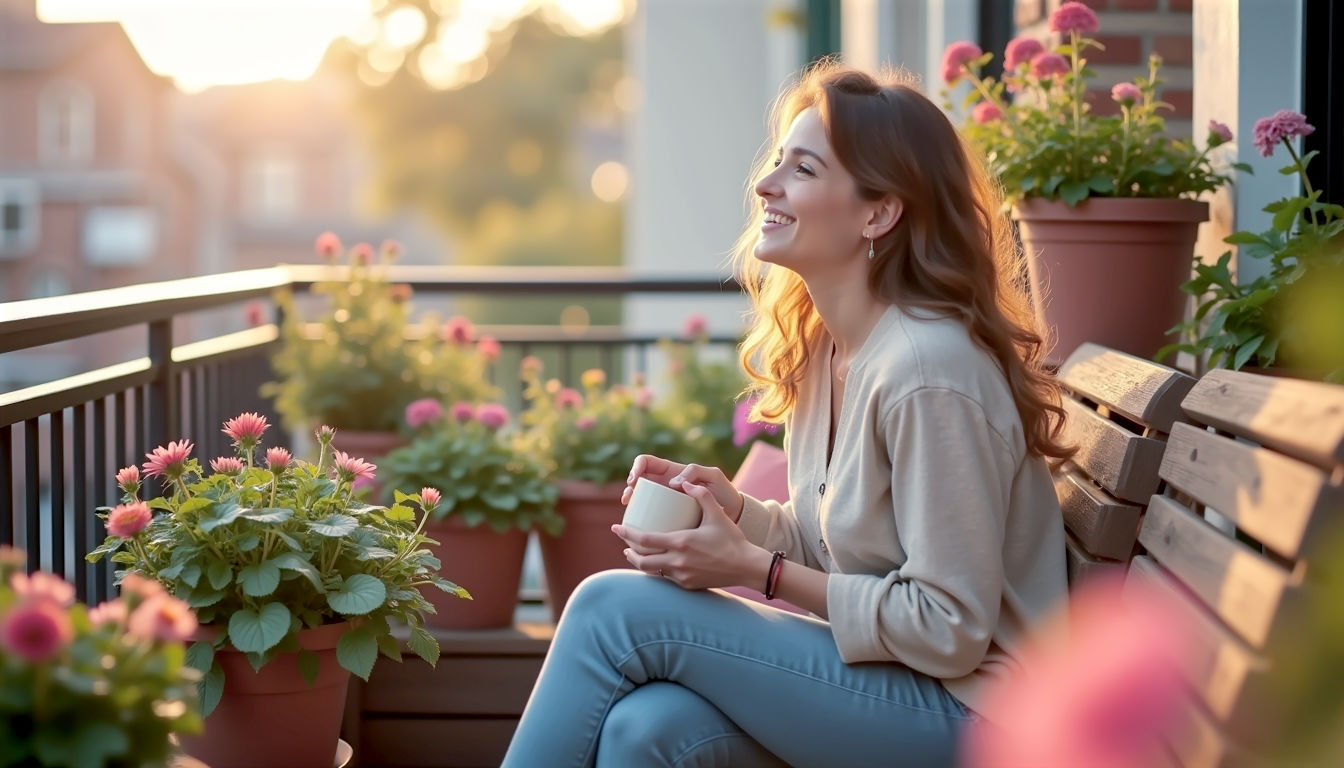
The key is to experiment, have fun, and not be afraid of failure. Every gardener, without exception, has killed plants. It’s how we learn. Start small, perhaps with a pot of herbs or some tough-as-old-boots geraniums. Learn what works for you and your space.
In our small, crowded island, these miniature gardens are more important than ever. They are a patch of green in a grey world, a source of joy and food, and a reminder of the quiet, steady rhythm of the seasons. So grab a pot, a bag of compost, and a plant that makes you smile. Your very own British garden is waiting to be created.
Further Reading & Resources
For more inspiration and expert advice, explore these highly respected UK gardening resources:
- Royal Horticultural Society (RHS): The UK’s leading gardening charity, their website is an encyclopaedia of reliable planting and care advice. https://www.rhs.org.uk/
- BBC Gardeners’ World: The online home of the beloved TV programme, filled with practical tips, videos, and timely advice from experts like Monty Don. https://www.gardenersworld.com/
- The English Garden Magazine: A source of beautiful inspiration, featuring stunning gardens from across the country. https://www.theenglishgarden.co.uk/
- Sarah Raven: A renowned plantswoman whose website offers a beautifully curated selection of plants and expert guides on creating stunning container displays. https://www.sarahraven.com/

